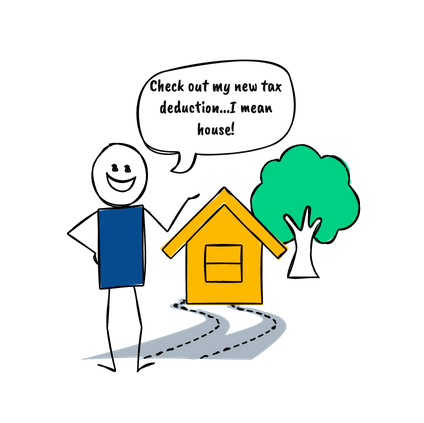Up to this point, in most discussions and examples, I have defaulted to the standard deduction for most federal income tax calculations. There is a reason. As noted in a previous article, tax brackets are at historic lows, and the standard deduction is historically high. Together, these things make it less likely that a taxpayer or household will benefit from itemizing.

But that’s not true across the board. Before I started making Qualified Charitable Distributions (QCDs) from my IRA at age 70.5, my wife and I were itemizing—and we didn’t have a mortgage interest deduction. However, we’re better off with the standard deduction with QCDs (which are tax-free and count toward our Required Minimum Distributions—RMDs). I can do my taxes in about 15 minutes!
Whether you do one or the other, remember that our goal is to reduce the tax we pay (relative to our income and investment earnings) over our lifetime. Therefore, we want to ensure we are not “leaving money on the table” by always taking the standard deduction. Sometimes, itemizing will make more sense, especially as you get older.
So, in what circumstances would you find it more advantageous to itemize? As you might imagine, it would be whenever you have more itemized deductions than the standard deduction. Here are the numbers for 2025 based on filing status for comparison (they’re slightly higher than 2024):[1]
- Single Filers: $15,750
- Married Filing Jointly: $31,500
- Heads of Household: $23,250
As you can see, a young married couple must come up with more than $30,000 in itemized deductions to make it worth itemizing. But how would you? Well, here are the major categories that you might be able to use; it all depends on the amounts and what they add up to.
First is mortgage interest paid on a loan to purchase a primary (and sometimes secondary) residence. It must be interest on the first $750,000 of a first or second mortgage taken out after December 15, 2017, and up to $ 1 million of the mortgage on houses purchased before December 16, 2017.[2]
Starting in 2026, private mortgage insurance (PMI) counts too! If you’re a first-time homebuyer, this could be a meaningful deduction.
The amount of interest will vary depending on your progress on the amortization payment schedule—you pay more interest during the early years and less later—but let’s assume a $450K 30-year fixed-rate mortgage at 4.5% was taken out in 2020. In 2024, you would have paid about $19,000 in interest.
Next are state and local taxes (SALT). These include state income taxes, local property taxes, and other similar taxes. The OBBBA raised the limit to $40,000 in 2025, but we’ll assume yours is $9,000. You’re now up to $28,000 in itemized deductions (=$19,000 + $9,000).
Charitable donations are another big category for some people. Perhaps you give a cash donation of $2,000 to your church. These are deductible up to 60% of Adjusted Gross Income (AGI), so you’re good. Your total itemized deductions are now up to $30,000 (=$28,000 + $2,000), which is still a little under the standard deduction. But we’re not through yet.
Another major category of deductible expenses is out-of-pocket medical and dental costs. It also includes health insurance premiums (if not through a pre-tax employer plan), doctor visits, prescriptions, and long-term care expenses. You can’t deduct cosmetic procedures or reimbursed expenses. However, only the portion that exceeds 7.5% of the adjusted gross income (AGI) is deductible. You are pretty healthy and have an employer health plan, so your costs don’t exceed 7.5% of AGI. You’re still at $30,000 in itemized deductions.
The last deduction you may have is student loan interest, but it is NOT actually an itemized deduction. As you may recall from the Taxable Income (#24) article, this is an “above-the-line” deduction and, therefore, not itemized on Schedule A (Form 1040). But since you have some student debt, we’ll include it. You can deduct up to $2,500 per year, but you paid $2,200. You’ll take that amount as an income adjustment (above the line) and reduce your AGI, reducing your taxable income. So, we’ll assume that is already baked into your AGI.
With a total deduction of $32,200, you have edged into the “best to itemize” category ($32,200 > $31,500), but not by much. This is the simple math that your tax software or preparer must do to decide which approach is optimal for you.
But notice what happens if we change one big assumption. Let’s say you are renting instead of paying mortgage payments. Your itemized deductions go from $32,200 to $13,200 (= $32,200 – $19,000); ouch! In that case, you would be MUCH better off taking the standard deduction of $31,500.
The math is pretty simple: the marginal benefit of itemizing is directly proportional to the amount of itemized deductions over the standard deduction. In those cases, the benefit is the marginal amount times your marginal tax rate. For example, if you had $32,000 in itemized deductions, the marginal benefit of itemizing is $500 (= $32,000 – $31,500). If your marginal tax bracket is 22%, your tax savings would be $110 (= .22 x $500 ). That’s not a huge sum, but 100 bucks is 100 bucks.
Also worth noting is that as a married homeowner who can, therefore, take the $19,000 interest deduction and the $9,000 SALT deduction but have no other deductions, you will get zero tax benefit from home ownership since your itemized deductions would be $28,000, which is $3,500 less than the standard deduction. This is the result of the law tax rates and high standard deductions that were first enacted into law in 2017 and then made permanent by the OBBBA in 2025.
The changes to the deductible mortgage interest (to include PMI) and an increase in the SALT limit (to $40,000) by the OBBBA have made home ownership more attractive from a tax standpoint. But that doesn’t mean it will always be a slam dunk with the standard deduction remaining high. Still, it may be easier to get over the $31,500 standard deduction hurdle. So, home ownership might make economic sense and be desirable for other reasons, with possible tax savings as a bonus.
One more (big) thing that can impact your taxes is having children. Kids come with tax benefits, but it’s safe to say that it costs more to raise them than any tax benefits you might get. The Bible says that children are a blessing, and they are, but they are also crawling, walking, talking, and crying little money pits that can present financial challenges. Still, knowing the tax benefits of having children would be wise.
The most significant benefit is the Child Tax Credit. A couple with two children under the age of 17 can receive a credit of $2,200 per child. (A tax credit directly reduces your taxes owed, not your taxable income.) However, an income phase-out begins at $400,000 for married filing jointly; it phases out by $50 for every $1,000 over the limit.
Having children may give you other credits, such as the Child and Dependent Care Credit, which helps offset childcare costs. The cost is $3,000 per child, with a maximum of $7,500 per family. The credit is 20% to 35% of qualifying expenses based on your income. Having children may also increase your medical expense deduction, but it’s capped at 7.5% of AGI.
Other credits, such as the Earned Income Tax Credit (EITC), are income-specific (typically when your “Modified Adjusted Gross Income, or MAGI, comes back into play). It is a refundable tax credit for low- to moderate-income workers. The maximum credit for a family with two children is $7,830 for 2024. Their income must be less than approximately $63,400. More kids mean a larger credit, but phase out with higher incomes.
Note: This is the last “Lever #2: Taxes” article. Next up: “reducing consumption.” Spending is a “negative,” at least in your ledger (a lot of spending can be positive in other ways), so the idea is not to consume goods and services such that you spend more than you earn. Plus, the more you consume and spend as a percentage of your total income, the less you’ll have to use for other purposes.
For reflection: Most people know they can no longer get a tax deduction for charitable giving unless they itemize, which is limited to 60% of their AGI. From a biblical perspective, that should never be the reason for giving in the first place; it should be done from a willing and cheerful heart, with tax deductibility seen as a “side benefit.” If you are young, chances are you have never itemized on a tax return. But let’s say you did and deducted your charitable contributions, but you now use the standard deduction. Would you have continued giving or cut back due to the lack of a tax benefit?
Verse: “The point is this: whoever sows sparingly will also reap sparingly, and whoever sows bountifully will also reap bountifully. Each one must give as he has decided in his heart, not reluctantly or under compulsion, for God loves a cheerful giver” (2 Corinthians 9:6-7, ESV).
Resources:
Tax preparation and filing services:
- https://www.e-file.com/
- https://www.freetaxusa.com/
- https://turbotax.intuit.com/
- https://www.taxslayer.com/
- https://www.hrblock.com/online-tax-filing/
Notes:
[1] These include the increases in the OBBBA tax law enacted in 2025.
[2] This provision was made permanent by the OBBBA in 2025.
